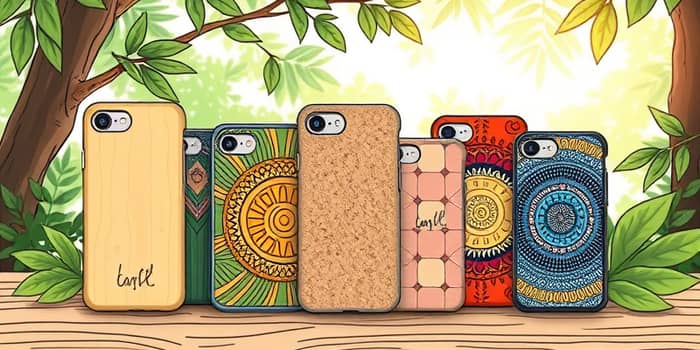The mobile accessories industry is experiencing a profound transformation as consumers embrace eco-friendly alternatives. Among these, compostable phone cases have emerged as a symbol of environmental responsibility, creativity, and technological innovation. By marrying style, performance, and sustainability, these cases are not only protecting our devices but also returning to the environment naturally at the end of their life cycle. This article delves into the market dynamics, technological breakthroughs, consumer behaviors, and the broader impact of compostable phone cases on the future of tech accessories.
Market Growth and Economic Context
Over the past decade, the eco-friendly phone cases market has witnessed exponential expansion. Valued at approximately $1.2–$1.3 billion in 2024, this sector is projected to climb to between $2.5 billion and $3.7 billion by 2033. Within this arena, the compostable phone cases segment alone was valued at $500 million in 2025 and is expected to grow at a CAGR of 15% through 2033. The broader eco-friendly category—encompassing recycled and biodegradable materials—reached as high as $10.2 billion in 2024, reflecting mounting consumer demand for sustainable solutions.
Meanwhile, the overall mobile cases and covers market, which includes all materials, surpassed $27 billion in 2025. This massive addressable market highlights an opportunity for brands to pivot toward compostable alternatives that resonate with eco-conscious buyers. As global awareness of plastic waste intensifies, the shift to compostable options represents a compelling growth story powered by both innovation and consumer ethics.
What Makes Compostable Phone Cases Different
Compostable phone cases stand apart through their composition. Made from materials like PLA, PBAT, bamboo fiber, cork, and straw fiber, these cases are designed to break down naturally under composting conditions without leaving harmful microplastics behind. Unlike petroleum-based plastics that can linger in the environment for centuries, compostable materials biodegrade into harmless organic matter.
Beyond their environmental benefits, these cases offer exceptional design versatility. Manufacturers leverage natural textures—such as the grain of bamboo or the subtle pattern of cork—to create visually striking and tactilely pleasing products. Customization options abound, with choices ranging from solid colors to intricate patterns, laser engraving, and built-in impact protection. This combination of form and function has helped compostable cases gain traction not just among green consumers but also style-conscious buyers seeking unique accessories.
Key Market Drivers
- Increasing consumer environmental awareness and concern over landfill waste.
- Rising e-waste generation and demand for circular economy solutions.
- Innovation in durable, attractive compostable materials that rival plastics.
- Brand partnerships and sustainable initiatives that influence purchasing decisions.
These drivers are further enhanced by regulatory pressures and corporate sustainability goals. As governments and organizations adopt stricter waste reduction mandates, manufacturers are compelled to invest in greener materials and product life-cycle management strategies.
Key Industry Players
Several pioneering brands have positioned themselves at the forefront of the compostable case revolution. Pela Case, known for its fully plant-based, biodegradable lineup, has forged partnerships with environmental organizations to amplify its impact. CASETiFY, Reboxed, and Wild Case also offer compelling alternatives, fusing style, durability, and sustainability. These market leaders benefit from increased brand loyalty, positive press coverage, and partnerships that underscore their commitment to environmental stewardship.
By establishing high benchmarks for quality and eco-performance, these companies set the tone for the entire accessories industry. As a result, even traditional manufacturers are exploring compostable or recycled materials to remain competitive and socially relevant.
Consumer Trends and Preferences
Today's consumers demand more than just functional accessories; they seek products that align with their personal values. The rise of ethical consumerism has led buyers to scrutinize supply chains, material origins, and end-of-life disposal. Consequently, compostable phone cases appeal to those who want products that leave a positive environmental impact without compromising on style or protection.
Customization remains a critical selling point. Buyers can choose bespoke color palettes, add personal logos, or select from a gallery of artisanal patterns. This personalization fosters a deeper emotional connection between the user and their device, transforming a utilitarian accessory into a statement piece.
Challenges and Opportunities
- Higher production costs compared to conventional plastics, though economies of scale are improving affordability.
- Material limitations necessitate ongoing research and development.
- Competition from recycled-plastic and biodegradable alternatives that may offer similar benefits.
However, these challenges present significant opportunities. Continued R&D in plant-based polymers promises to uncover new compounds with enhanced toughness and flexibility. Brands that excel at multi-functional features—such as integrated lanyards, shock absorption, and antimicrobial coatings—will differentiate themselves in a crowded marketplace.
Product Types and Features
Compostable phone cases come in various forms, catering to different consumer needs and device models. From slim back covers to robust full-body protectors, manufacturers aim to replicate—and improve upon—the performance of plastic counterparts.
Materials such as PLA (polylactic acid), PBAT, and bamboo fiber provide a sturdy foundation, while cork and straw fiber add unique textures. As manufacturing techniques evolve, we can expect greater color fidelity, thinner profiles, and improved tactile sensations.
Sustainability Impact and Future Outlook
Traditional phone cases often end up in landfills, contributing to long-term environmental pollution. Compostable options directly address this by ensuring products fully embrace a circular economy—returning to soil as organic matter. This cradle-to-cradle approach reduces landfill burden, lowers carbon footprints, and inspires other tech categories to follow suit.
Regulatory support, such as bans on single-use plastics and incentives for green manufacturing, will continue to accelerate market growth. Industry estimates predict sustained double-digit CAGRs as material science breakthroughs lower costs and broaden applications. Companies that invest now in compostable tech accessories secure a leadership advantage, demonstrating that profitability and sustainability can go hand in hand.
In conclusion, compostable phone cases are more than a niche trend—they are a clarion call for responsible innovation in consumer electronics. By choosing these products, consumers champion environmental stewardship without sacrificing quality or style. As the market expands, the combined efforts of manufacturers, brands, and eco-conscious buyers will shape a cleaner, greener future for tech accessories.
References
- https://www.businessresearchinsights.com/market-reports/eco-friendly-phone-cases-market-121551
- https://markwideresearch.com/compostable-phone-cases-market/
- https://www.archivemarketresearch.com/reports/compostable-phone-cases-523757
- https://www.futuremarketinsights.com/reports/mobile-cases-and-covers-market
- https://www.nextmsc.com/report/eco-friendly-phone-cases-market-3348
- https://www.marketresearchintellect.com/product/eco-friendly-phone-cases-market/
- https://www.lovingcase.com/blog/why-you-should-launch-eco-friendly-compostable-phone-case-collection/
- https://www.thebusinessresearchcompany.com/report/compostable-packaging-global-market-report










